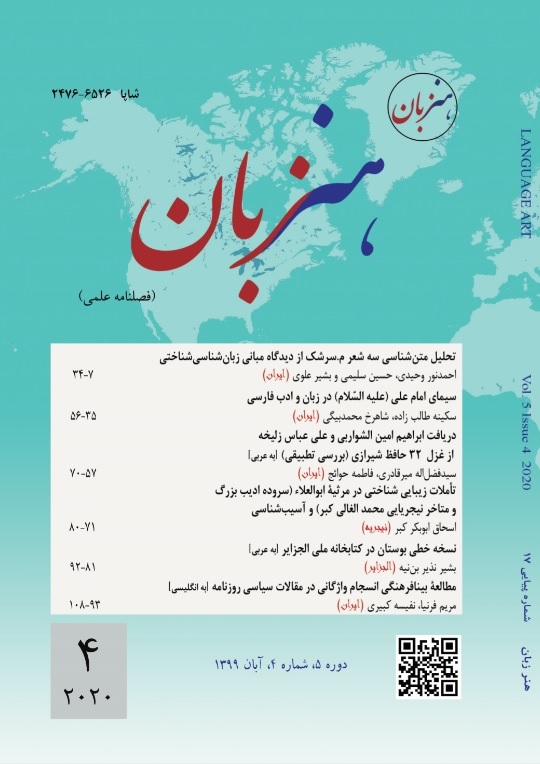تحلیل متنشناسی سه شعر م.سرشک از دیدگاه مبانی زبانشناسیشناختی
DOI:
https://doi.org/10.22046/LA.2020.19الكلمات المفتاحية:
شفیعی کدکنی، لیکاف، جانسون، زبانشناسی، طرحوارهالملخص
این مقاله به بررسی مـؤلفههای نظریه زبانشناسانشناختی با رویکردی متفاوت در سه شعر شفیعی کدکنی میپردازد. بررسی شناخت این گزارهها در چهارچوب نظریه جورج لیکاف و جانسون صورت میگیرد که در این چهارچوب در چند بحث طرحوارهها، استعاره شناختی، فردیت استعاره و موتیفهای آن به تحلیل شناختی متن پرداخته میشود. با خوانش این نوع نقد، ازلحاظ نگاشت نظام و جریان زبانشناسیشناختی به جهان فکری و ترسیم ساختار شعر شاعر میتوان دستیافت. این پژوهش نشان می دهد، چگونه عناصر زبانی و برجستگیهای زبان و طرحوارهها و استعارههای جهتگیرانه که مبانیشناختیان است، میتوانند میان فرم و محتوا و باور نویسنده و زبان خودکار ارتباط قائل شوند و ثابت شود که تشابه و همسان سازی نمونه های این نظریه در بحث طرحواره ها و استعارهها در این سه شعر شفیعی کدکنی آشکار است و میتوان دریافت که فرم این سه شعر، با جریانات فرمالیسم که از خروجی مبانی زبانشناسیشناختی است تناسب و هم سویی قابل توجهی دارد. شواهد نشاندهنده آن است که علاوه بر حضور استعاره جهتگیرانه و طرحوارههای مختلف در شعر شفیعی، اتفاق چند طرحواره و استعاره بر یک متن مشابه نیز ایجادشده است و استعارهها علاوه بر نوگرایی در جریان متن، تن به ایدئولوژی مشخص ندادهاند. در این پژوهش به استخراج نمونهها و شاهد مثالهای مطابق با این مفهوم از اشعار شفیعی کدکنی مبادرت ورزیده میشود. این مقاله با روش توصیفی و تحلیلی انجام شده است.المراجع
Bakhtin, Michael. (1994). sodā-ye mokāleme, xande, āzādi, translated by Mohammad Jafar Poyandeh, Tehran: Sherkat Farhani Honari Arst.
Biabani, Ahmad Reza and Talebian, Yahya (2012). A Study of Oriental Metaphor and Visual Schemas in Shamloo Poetry, Journal of Literary Criticism and Rhetoric, Volume 1 Number 1, Summer and Fall 2012, pp. 99-126. Digital Identifier (DOI): 10.22059 / jlcr.2012.35239
Borshe et al. (2007). Linguistics and literature, translated by Cyrus Safavi, Tehran: Hermes.
Dehghan E, Taghavi M. (2010) Motif, Types and Functions in Sadeq Hedayat's Story. LCQ. 2010; 2 (8), 41-67.
Fatouhi, Mahmoud (2011). sabkʃenāsi, nazariyehā, roykardhā va raveʃhā, Tehran: Sokhan.
Golfam A, Yousefi rad F. (2002). Cognitive Linguistics and Metaphors. Advances in Cognitive Sciences. 2002; 4 (3):59-64.
Hasandokht Firooz Sima, Golfam Arsalan. (2009). Cognitive study of time metaphor in Forough Farrokhzad's poems. LCQ. 2009; 2 (7) :121-136.
Haynes, John (1995) Style. London. New York: Routledge.
Lakoff, George (1992) the contemporary theory of metaphor in ortory. Andrew (ed) metaphor and thaught. Cambridge: Cambridge unverstity press.
Lakoff, George and Mark Johnson. (1989) metaphor we live by. Chicago: university of Chicago press.
Lakoff, George (1993) the contemporary theory of metaphor in Geeraets. Dirk (editor) 2006. Cognitive linguistics: basic readings (congntive linguistics resarch: 34). Berlin. Newyork: mouton de Gruyter. pp. 187-238.
Langacker, R. W. (1987). Foundations of Cognitive Grammar: Theoretical prerequisites (Vol. 1). Stanford university press.
Paul Ricoeur (2007). The Metaphorical Process, (in David Stewart, Exploring the philosophy of Religion, 4th ed, 1998, prentice-Hall, p.189-200), Journal of Marifat, Volume 16, Number 20. pp. 81-94.
Safavi, Korash (2000). An Introduction to Semantics, Tehran: Pazhuheshgah-e Farhang va Nashr Islami.
Safavi, Kourosh, (2003) Discussion on Schemas and Images from the Perspective of Cognitive Semantics, Farhangistan Quarterly, No. 21, pp. 65-85.
Selden, Raman (1985). Contemporary Literary Theory, translated by Abbas- Mokhbar, Tehran: Tarhe Nou.
Shafie’i Kadkani, Mohammad Reza (2010, a.), bou-ye jo-ye mouliān, Tehran: Sokhan.
Shafie’i Kadkani, Mohammed Reza (2010, b.), dar kouche bāqhā-ye Neyshābour, Tehran: Sokhan.
Shamlou, Ahmad (1993). marsiyehā-ye xāk, 5th Ed., Tehran: Zamaneh.
Croft, W., & Cruse, D. A. (2004). Cognitive linguistics. Cambridge University Press.
Van Peer W and Hakemulder J (2006), Foregrounding. In: Keith Brown, (Editor-in-Chief) Encyclopedia of Language & Linguistics, Second Edition, volume 4, pp. 546-550.
Willie van Peer (1986). Stylistics and psychology: Investigations of foregrounding. London: Croom Helm
التنزيلات
منشور
كيفية الاقتباس
إصدار
القسم
الرخصة
الحقوق الفكرية (c) 2020 احمدنور وحیدی, حسین سلیمی, بشیر علوی

هذا العمل مرخص بموجب Creative Commons Attribution 4.0 International License.

